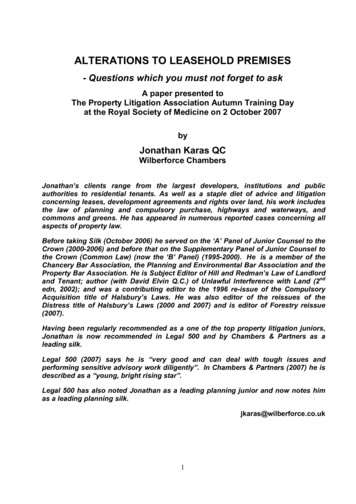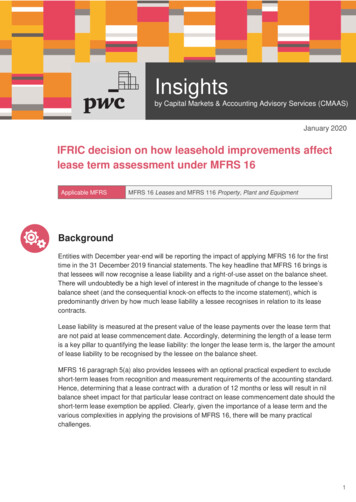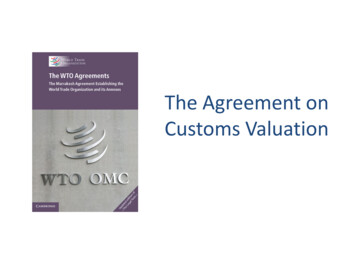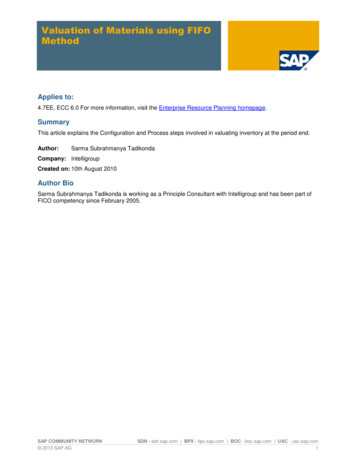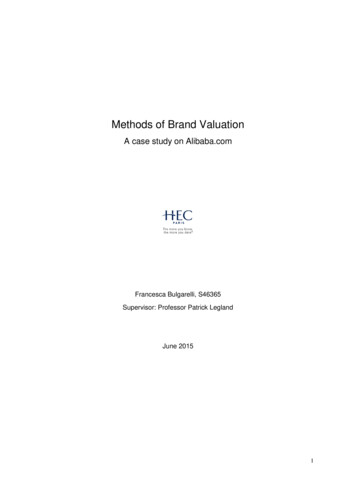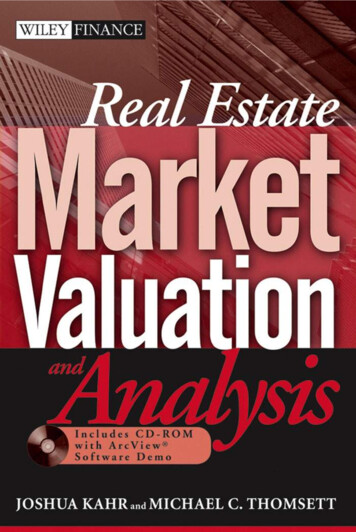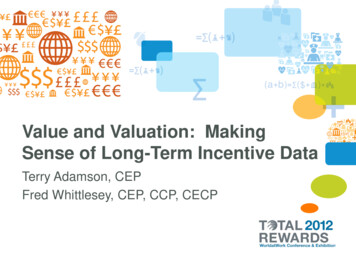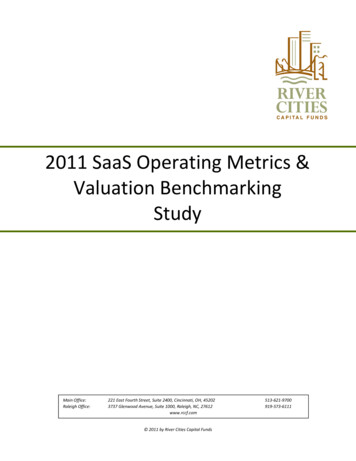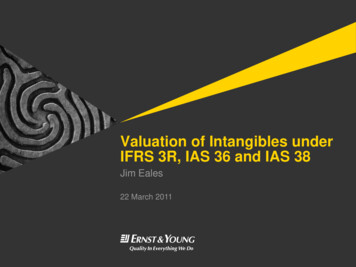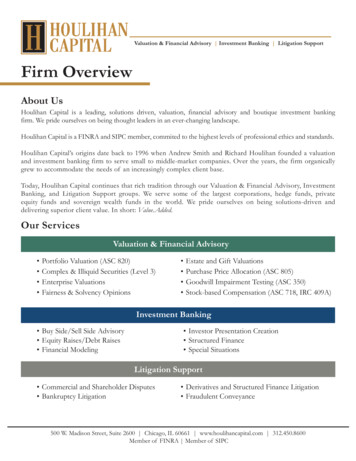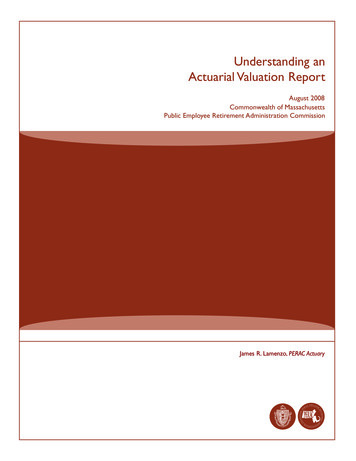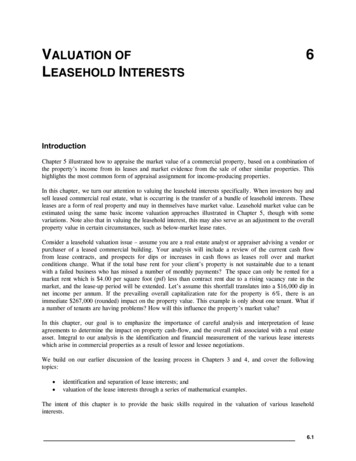
Transcription
VALUATION OFLEASEHOLD INTERESTS6IntroductionChapter 5 illustrated how to appraise the market value of a commercial property, based on a combination ofthe property’s income from its leases and market evidence from the sale of other similar properties. Thishighlights the most common form of appraisal assignment for income-producing properties.In this chapter, we turn our attention to valuing the leasehold interests specifically. When investors buy andsell leased commercial real estate, what is occurring is the transfer of a bundle of leasehold interests. Theseleases are a form of real property and may in themselves have market value. Leasehold market value can beestimated using the same basic income valuation approaches illustrated in Chapter 5, though with somevariations. Note also that in valuing the leasehold interest, this may also serve as an adjustment to the overallproperty value in certain circumstances, such as below-market lease rates.Consider a leasehold valuation issue – assume you are a real estate analyst or appraiser advising a vendor orpurchaser of a leased commercial building. Your analysis will include a review of the current cash flowfrom lease contracts, and prospects for dips or increases in cash flows as leases roll over and marketconditions change. What if the total base rent for your client’s property is not sustainable due to a tenantwith a failed business who has missed a number of monthly payments? The space can only be rented for amarket rent which is 4.00 per square foot (psf) less than contract rent due to a rising vacancy rate in themarket, and the lease-up period will be extended. Let’s assume this shortfall translates into a 16,000 dip innet income per annum. If the prevailing overall capitalization rate for the property is 6%, there is animmediate 267,000 (rounded) impact on the property value. This example is only about one tenant. What ifa number of tenants are having problems? How will this influence the property’s market value?In this chapter, our goal is to emphasize the importance of careful analysis and interpretation of leaseagreements to determine the impact on property cash-flow, and the overall risk associated with a real estateasset. Integral to our analysis is the identification and financial measurement of the various lease interestswhich arise in commercial properties as a result of lessor and lessee negotiations.We build on our earlier discussion of the leasing process in Chapters 3 and 4, and cover the followingtopics: identification and separation of lease interests; andvaluation of the lease interests through a series of mathematical examples.The intent of this chapter is to provide the basic skills required in the valuation of various leaseholdinterests.6.1
Chapter 6Identification of Interests in a Leased PropertyVarious legal interests may exist in a leased property. A real estate analyst must be able to recognize: how interests arise in a property;limitations on the extent of the interests; andthe methods used to value each interest.The valuation of an interest held by lessor, lessee, or sub-lessee is challenging for a number of reasons.First, this is an assignment that most valuators and consultants encounter rarely. Secondly, the identificationand quantification of an interest is difficult when market information is limited. Thirdly, there areexceptions, nuances, and limitations in the valuation process which must be recognized. Lastly, themathematics of leasehold valuation tends to become involved and complicated.However, whatever the interest to be valued or technique to be used, the final outcome must stand the test ofmarket value. The difficulty arises when some interests are so unique that they fail the notion of an open andcompetitive market or the market conditions of willing buyer/willing seller.At this point you are probably wishing you could fast forward to the next chapter .not so fast. We willdemonstrate, through many examples, how you can tackle the most common and difficult valuation ofinterests in leased property. As in the case of almost all real property analysis, you will find that successcomes with a combined understanding of the appropriate analytical process coupled with experience andcommon sense.Identification of InterestsOur initial focus is to identify the distinct interests related to the leased property and explain the valuationmethods used to value each interest. Let’s begin at the top, the fee simple interest held by the owner of theproperty and work on down the hierarchy of possible interests so you have a picture of how the variousinterests are related.Fee Simple InterestThe fee simple interest is the most complete interest in real estate where the title is only encumbered by thefour powers of government: taxation, land-use controls (police power), eminent domain, and escheat(reversion of title to government when an owner dies intestate). To capture the concept of completeownership, the unencumbered fee simple interest is sometimes referred to as a complete bundle of rights. Inreality, the title to most property is less than unencumbered fee simple since it can be affected by amortgage, easement, covenant, or some other form of charge affecting the bundle of rights.Valuation of the fee simple estate is the most common property valuation assignment for appraisers. Thevalue is relevant not only to the owner who has encumbered the property with lease agreements, mortgagesand other charges, but also to a lender or a potential investor. If an appraiser is asked to value a propertywith leases in place, the assignment will be a valuation of the encumbered fee simple interest. Moreover, inall Canadian jurisdictions, assessors are required by legislation to determine the fee simple estate forproperty assessment and taxation purposes. This legal requirement is intended to ensure that assessments areconsistent and equitable.6.2
Valuation of Leasehold InterestsAn important initial task for an appraiser who is valuing the fee simple interest in a leased property is todetermine whether the lease rents are representative of market rents and whether adjustments are required tothe property rents or the overall capitalization rate to reflect market conditions. The capitalized value of thefee simple interest in property is typically determined by capitalizing market rent for the property, with amarket derived overall capitalization rate.Let’s now move to the next level of ownership interest: the leased fee estate.Leased Fee EstateThe leased fee estate is the ownership interest held by the lessor (landlord), which includes the right toreceive the rent specified in the lease, plus the reversionary right when the lease expires.When a fee simple owner (lessor) leases their property to a second party (the lessee), a partial estate iscreated. The lessor’s property interest is known as the leased fee estate. While the lessor retains ownershipof the property, the legal title is subject to the rights conveyed in the lease. The challenge in the valuation ofthe leased fee or lessor’s interest is determining the rights conveyed in the lease to receive rent and theextent to which the lease improvements have value at the expiry of the lease.You are probably wondering how the value of a leased fee interest is different from the value of fee simpleproperty. The answer is that the two values may not be different if the lease contract rents reflect marketrents. Remember – a key initial step in the appraisal process is the identification of whether the rents are atmarket. In contrast, the goal of a leased fee valuation is to analyze the contract rents in the leaseagreement(s) rather than market rent.A landlord or lessee may require a valuation of the leased fee interest in their income property for: corporate re-structuring;sale of partnership interests, wind-ups;estate purposes;sale of the property; orlong-term ground leases associated with build-to-suit projects such as Big Box Stores.Leased fee valuation assignments may be associated with long-term lease agreements where there is littleopportunity to achieve current market rent. For example, a 30 year ground lease may be structured torestrict periodic rent escalation to adjustment according to changes in the consumer price index for the localmarket area. In these types of agreements, the lease is analogous to a long-term bond. In this scenario, thelessor accepts a fairly secure and certain return on his investment in exchange for the potential risk that therent will fall behind market rent over the term of the lease.The value of the interest is the sum of the present value of the net operating income during the term of thelease and the present value of the reversion at the end of the lease. Let’s consider a typical build-to-suitscenario where a prominent national tenant acquires land, builds a commercial building to theirspecifications, and sells the building upon completion to an investor. The investor then enters into a longterm lease agreement with a tenant (i.e., Wal-Mart, Home Depot, Rona, etc.). In these scenarios, the goalof the national tenant is to control all aspects of the construction and site planning process but not have theircapital tied in the ownership of the property. The provisions for reversion of the lessee’s improvements atthe end of the term are an important consideration.6.3
Chapter 6Let’s assume that the Royal Bank enters into an agreement with a developer as follows. Developer selects site which meets bank’s retail banking location requirements.Developer acquires property and builds a retail bank according to Royal Bank’s specifications.Royal Bank signs a lease with the developer for a 30-year term, with 5-year rent reviews. Rent isestablished at the greater of market rent or the rent in the last year of the preceding term.The bank building may or may not have remaining economic life at the end of the term. If the leasehas a clause which requires removal of the improvements and sub-structures at the option of thelessor at the end of the term, the lessee may have a negative reversionary value related to this futureliability.A practical example of the reversion issue is a build-to-suit leased Royal Bank building located across fromthe Richmond Centre Shopping Centre in Richmond, BC. The bank is designed as a typical two-storey retailbank, with a large surface parking lot on a prime corner. When the bank was first constructed, the generalarea was improved with a mix of older single-family housing and strip malls. In 2009 the Canada Line(Skytrain) was extended from Vancouver into Richmond with the Richmond line terminus located across thestreet from the Bank. Over the passage of time, the houses have disappeared, strip malls have beenconverted to modern neighbourhood plazas with national brand retailers, and mixed-use projects arecommon. The highest and best use of the property is likely a much higher commercial density, perhaps amulti-storey condo and ground level commercial units. In this scenario, the owner may receive offers to sellthe property which exceed the leased fee value.Our main point with this example is to be very cautious when dealing with reversions. Ensure you have afirm basis for assigning value to an asset where the value will only be realized in the long-term. It’s difficultfor any analyst to reliably forecast market conditions for 6 months. You may be attempting to forecastmarket conditions 20 or 30 years in the future!Leasehold EstateThe leasehold estate is the right held by the lessee to use and occupy real estate for a stated term and underthe conditions specified in the lease. The leasehold estate is the complement of the leased fee estate held bythe landlord in that the value of the fee simple interest in the property would consist of the sum of the valueof the leased fee interest, plus the value of the leasehold interest.Similar to the leased fee estate, a leasehold estate is a partial estate that exists only during the term of thelease. When valued, the interest is known as the “value of the leasehold estate” or lessee’s interest.The value of a leasehold estate is the difference in the present value between market rent and contract rent(i.e., the excess rent, assuming market rent exceeds contract rent) for the remainder of the term, includingthe value of all rent incentives provided by the landlord (e.g., free rent period, fixturing allowance, etc.).A simple example of a leasehold interest is a retail tenant who operates a drug store in a strip mall. Thetenant has secured a lease for 5,000 sq. ft. with a 10-year term at a fixed rate of 20.00 psf, escalating to 22.00 psf in year 6 of the term. By year 3 of the lease, market rents for similar space have increased to 23.00 psf. Given positive market conditions it is possible that rents will continue to rise. The tenant has aminimum 3.00 psf rent advantage for years 3 to possibly year 5 and beyond, amounting to a minimumrental advantage of 15,000 in rent per year for at least 3 years.The difficulty is forecasting continued strength in the retail market for periods greater than the short-term.The other issue is that the tenant can only realize their potential leasehold interest by an assignment toanother party who is prepared to pay a fee for the right to obtain a below market lease, or enter into a sub6.4
Valuation of Leasehold Interestslease at market rent. Landlords are well aware of this possibility and most will ensure that the lease has aprovision to restrict the ability of a tenant to sub-lease or assign their interest for a profit.Sublessee’s InterestWhen the tenant or lessee subleases to a third party, a further interest is created in the property. The personto whom the sublease is given is known as the sublessee and the sublessee’s interest is known as the sub ortop leasehold estate. This estate exists only during the term of the sublease. The original lessee now becomesknown as the head le
In this chapter, we turn our attention to valuing the leasehold interests specifically. When investors buy and sell leased commercial real estate, what is occurring is the transfer of a bundle of leasehold interests. These leases are a form of real property and may in themselves have market value. Leasehold market value can be estimated using the same basic income valuation approaches .
